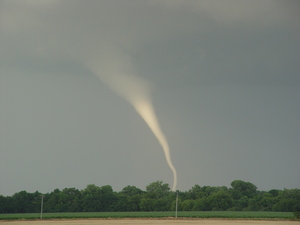At one minute after one o’clock in the afternoon of March 18th, 1925, the Great Tri-State Tornado touched down in the Ozarks in the state of Missouri. For the next three and one half hours this monstrous twister, generally agreed upon now as a category F5 on the Fujita Scale that measures these storms, tore a path through three states for a still-record distance of 219 continuous miles. The Tri-Stare Tornado killed almost 700 people, injured thousands, and damaged an area of 164 square miles, or more than fifty times the typical cyclone. The Tri-State Tornado of 1925 remains this nation’s deadliest tornado, as it blew through Missouri, Illinois, and into Indiana before finally dissipating.
The forward speed of the Tri-State Tornado averaged out at an implausible 62 miles per hour, as the twister ravaged 13 separate counties and 19 individual communities, wiping some of these off of the map. The Tri-State Tornado was a mile wide at some points and never less than three-quarters of a mile in width. It did not even resemble a tornado as it looked more like a “cloud eating the ground as it went along” according to one survivor. There was no weather radar or early warning system back in 1925, so those that lay in the route of the Tri-State Tornado had no way of knowing it was coming. The United States Weather Bureau at the time actually forbade the use of the word “tornado” in any of its forecast, in order not to panic the public, and its forecast that day was for unsettled weather with possible winds.
At 1:01 the Tri-State Tornado started in Ellington, Missouri, uprooting trees and killing a farmer. It continued on to the mining town of Leadanna and then to Annapolis, where it killed two and caused a half million dollars worth of destruction. Before the Tri-State Tornado had left the “Show Me State” it had killed eleven people. It moved across the Mississippi River and into Illinois at about 2:30, with the town of Gorham squarely in its sights. It annihilated Gorham, leaving nothing in the hamlet unscathed and taking 34 lives. Murphysboro was particularly hard hit next by the Tri-State Tornado, as 234 of its citizens met their maker from the storm, including 25 school kids in three different schools. 69 residents of De Soto, Illinois perished, with 33 of those fatalities coming at the local schoolhouse, still a record for a single school from one twister. Students and teachers alike were crushed as the walls fell in on them.
The tornado was so huge and so fast moving that it looked more like a massive area of fog rolling in. By the time people realized the danger it was too late. The Tri-State Tornado continued across Illinois in a northeasterly direction, carving up the countryside town after town. The powerful cyclone carried dust, dirt, and debris along with it. Lumber, tree limbs, and other objects were turned into lethal missiles by the winds that some have theorized reached up to 300 miles per hour. In the important mining center of West Frankfort, Illinois, the Tri-State Tornado passed over a mine with 800 men working inside of it, 500 feet below the surface. The tremendous rush of air the tornado generated blew down the ventilation shaft with the force of an explosion and the mine was evacuated. The miners had no idea what had occurred above them and climbed up the escape route to find that their homes and loved ones had been hit by the twister. 127 died, mostly women and children of the working miners, with another 450 left injured and almost all of the houses destroyed.
Rural parts of Illinois were obliterated by the Tri-State Tornado before it finally left the state, leaving behind 613 dead, another record for a single state from one tornado. The storm made its way across the Wabash River and into Indiana, having been in existence for almost three hours. At times, multiple funnels were visible as it claimed 71 lives in the Hoosier State. Children on their way home from school were killed in communities such as Griffin and Princeton, where the Tri-State Tornado finally fell apart, ten miles to the northwest of the town. It was now 4:30 in the afternoon, a remarkable three and a half hours after the twister first touched down almost 220 miles away.
The Tri-State Tornado of 1925 had traveled almost fifty miles further along the ground than the next longest recorded tornado, one that struck in Texas and Oklahoma in 1947. Weather experts have debated whether the Tri-State Tornado was one continuous storm or a series of tornadoes, but whatever the details, it had killed 695 people, the most by one storm. The property damages were estimated at 16.5 million dollars, a huge sum in those days. The Tri-State Tornado raised public awareness about the need for an effective warning system to deal with such disasters, but it would be many years before technological advancements made this a reality.
.




